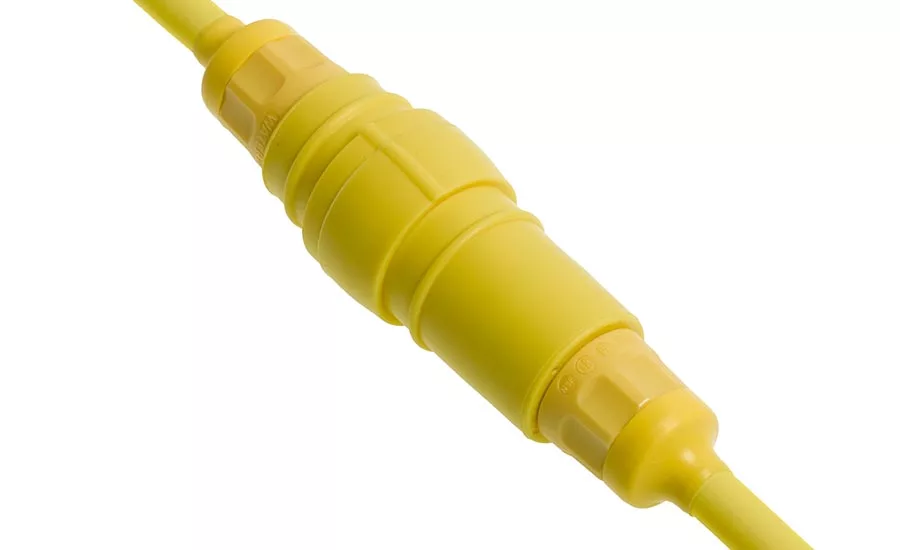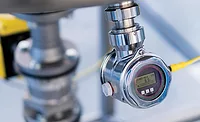Engineering R&D
Electrical connectors must survive harsh requirements, meet stringent standards

Tony Quebbemann, Molex global product manager

Woodhead Watertite Extreme plugs and connectors handle power applications carrying 120-600 volts AC with currents up to 50 amps for wet and harsh environments.
Photo courtesy of Molex
Some industrial environments—chemical processing, paper making, etc.—are known to be hostile to electrical connectors. Food and beverage environments are just as much of a challenge to good connector design and construction as their extreme industrial counterparts.
But in the food industry, good design has to go a step further. It should be a fully inclusive solution that encompasses the electrical safety requirements including UL and CSA, the NSF food equipment requirements, the IEC extreme sealing requirements, and the trusted materials identified by the FDA.
It’s a safe bet that any electrical engineer who has specified heavy-duty, sealed, watertight power cordsets and connectors is familiar with Molex’s Woodhead products. Woodhead Watertite wiring devices were the first completely watertight wiring products for heavy industrial usage when they debuted almost three decades ago. Recognizing the need to provide a cordset and connectors to meet food and beverage industry standards, Molex redesigned a connector family to provide the industry with a solution. Molex product design engineers looked at taking the original Woodhead vulcanized-rubber products and using new materials that comply with FDA specification 21 CFR 177.2600.
Why vulcanized rubber? It holds up better. Testing has shown that vulcanized rubbers have greater range of temperature performance, better resistance to severe abrasion, greater weather and UV resistance, and better water repelling than the commonly used alternative materials, such as TPE (thermoplastic elastomer).
Molex has recently released its Woodhead Watertite Extreme plugs and connectors for power applications carrying 120-600 volts AC with currents up to 50 amps for wet and harsh environments. I spoke with Tony Quebbemann, Molex global product manager, who’s been the driving force behind the development of the connector and cordsets.
FE: The connection product, the Woodhead Watertite wiring device, is known in the industry as the “14W47.” How is the food and beverage version different from its standard industrial counterpart?
Tony Quebbemann: It is true that the Woodhead original catalog number, 14W47, has become an industry icon followed upon and used now by most all watertight brands. Woodhead has kept this number as the high-level reference for use in both food and general industry, differing only from the newly introduced 14W47-P, which is designed for use in the petrochemical industry. While both versions use industry-proven vulcanized rubber, the main difference is the addition of silicone for the 14W47, making it ideal for food applications and generally even better regarding chemical, abrasion and temperature resistance.
FE: How long was the food and beverage version in development? What design changes were needed for food and beverage?
Quebbemann: A very serious five-year development was completed with field input from many users and significant testing, where we worked seemingly tirelessly at times to model the real-life application environment within our lab. Industry-standard tests were performed but done consecutively reusing the same product. We did not simply want to verify the condition of our product upon crushing, but performed a leak test immediately following the crush test. We recognized the actual environment can have connectors on the floor, stepped on or driven over, that are exposed to water/humidity while simultaneously being crushed, so we tested many products to those same real-life conditions. The results of this testing put our traditional product on top, but our desire to remain a top-performing product in the eyes of the user had us search for an even better vulcanized rubber.
The results of our research and testing are consolidated by the following design changes:
- New advanced vulcanized rubber formula
- Silicone rubber materials to meet and exceed industry standards
- New compression nut
- New patented cable glove seal, allowing for a seamless transition from wiring device to cordset
FE: Did you have everything in stock to build the new device, or did you need to find new materials?
Quebbemann: From the beginning, we approached this project with eyes on the best possible solution even if that meant a change in components. We feel we have arrived at what our customers would see as optimum; material improvements to the 14W47 that hold to be backward compatible when mated to existing product. For example, customers have been happy to learn that independent of the 14W47 used, any Woodhead Watertite connection combination will result in passing the IP69K test.
FE: More specifically, can you describe the construction of the device, its vulcanized silicone rubber husk and the patented cable glove seal?
Quebbemann: These products are relatively costly to make given the press set times and permanent formation. Unlike TPE, these components cannot be reheated and reformed by being remixed in the front end of the production process. A vulcanized rubber part is formed into a more permanent part that wears like your car tire and takes on that long-lasting, permanent form. In the case of the cable glove seal, we created a natural water and particle shedding component to accommodate the familiar hanging vertical orientation of many of these products.
FE: What are the major approvals for the cordset/connectors?
Quebbemann: The approvals include:
- NSF certified—NSF International has been helping businesses in the agriculture, processing, food equipment, restaurant and retail industries to navigate the food safety and regulatory environment for nearly 70 years.
- JIS—Vulcanized silicone rubber designed to meet JIS Z 2801 to inhibit the spread of bacteria.
- UL Listed—UL is a global independent safety science company with more than a century of expertise innovating safety solutions.
- CSA certified—CSA International found that representative samples of this product met CSA’s published Standards for Safety intended for the Canadian market.
- IP69K rated—Superior water ingress protection designed for the most extreme washdown procedures, withstanding hot and high-pressure water, in addition to excessively dusty environments.
FE: In terms of testing, besides being watertight, what other physical conditions needed to be met for the connector?
Quebbemann: Woodhead performs independent testing above and beyond industry standards and regulations. The internal testing is designed to represent real-world applications and is performed in sequence, rather than standalone tests with new products. The eight internal tests are:
- High temperature/high pressure water test (IP69K)
- Cold temperature test (Reference UL 50E)
- Effective cleaning test (Reference ISO8296)
- Abrasion resistance test (Reference IEC 60068-2-31)
- Crushing test (as performed to meet UL 498)
- High pressure test after crushing test (test from IP69K standard)
- Submersion test after crushing test
- Internal sealing test
FE: One reason to use this material over TPE is that it doesn’t crack. Is this a safety consideration in wet environments in terms of shock hazards to workers?
Quebbemann: Rigorous, independent testing has proved that vulcanized rubber outperforms TPE products when exposed to chemicals, abrasion and other abuse, including high-pressure washdown. Although TPE products meet industry standards, independent testing has proven that vulcanized rubber not only meets minimum standards, but also exceeds industry standards and outperforms TPE materials.
FE: While a processor can buy the connectors and make up cordsets, are premade cordsets available?
Quebbemann: Woodhead Watertite cordsets are a standard product offering from Molex. We offer single, Y and W cordsets. We are the only manufacturer that offers GFCI-protected cord drops for food and beverage applications.
For more information, visit www.molex.com/woodhead
Looking for a reprint of this article?
From high-res PDFs to custom plaques, order your copy today!





